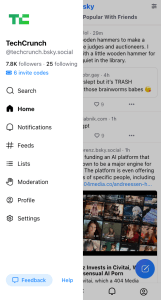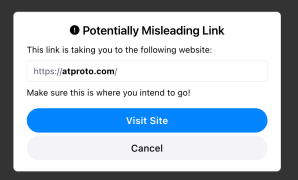Is
the
grass
greener
on
the
other
side?
We’re
not
sure,
but
the
sky
is
most
certainly
bluer.
It’s
been
over
two
years
since
Elon
Musk
purchased
Twitter,
now
X,
leading
people
to
set
up
shop
on
alternative
platforms.
Mastodon,
Post,
Pebble
(two
of
which
have
already
shuttered
operations)
and
Spill
have
been
presented
as
potential
replacements,
but
few
aside
from
Meta’s
Threads
have
achieved
the
speed
of
growth
Bluesky
has
reached.
As
of
February
2025,
Bluesky
has
surpassed
30
million
users.
Its
growth
stems
from
several
policy
changes
at
X,
including
a
heavily
criticized
change
to
the
block
feature
and
allowing
third
party
companies
to
train
their
AI
on
users’
posts,
which
helped
the
app
soar
to
the
top
of
the
U.S.
App
Store.
Bluesky
also
saw
a
big
boost
following
the
results
of
the
2024
U.S.
presidential
election
(which
also
contributed
to
an
X
exodus
by
Taylor
Swift
fans).
But
while
the
number
is
promising,
the
growth
has
slowed
—
and
the
network
has
a
lot
of
catching
up
to
do
to
compete
with
Threads’
275
million
monthly
active
users.
Below,
we’ve
compiled
the
answers
to
some
of
the
most
common
questions
users
have
about
Bluesky.
And
if
you’ve
made
the
switch,
you
can
follow
TechCrunch
here
as
well
as
our
team
with
our
Starter
Pack.
What
is
Bluesky?
Bluesky
is
a
decentralized
social
app
conceptualized
by
former
Twitter
CEO
Jack
Dorsey
and
developed
in
parallel
with
Twitter.
The
social
network
has
a
Twitter-like
user
interface
with
algorithmic
choice,
a
federated
design
and
community-specific
moderation.
Bluesky
is
using
an
open
source
framework
built
in-house,
the
AT
Protocol,
meaning
people
outside
of
the
company
have
transparency
into
how
it
is
built
and
what
is
being
developed.
Dorsey
introduced
the
Bluesky
project
back
in
2019
while
he
was
still
Twitter
CEO.
At
the
time,
he
said
Twitter
would
be
funding
a
“small
independent
team
of
up
to
five
open
source
architects,
engineers,
and
designers,”
charged
with
building
a
decentralized
standard
for
social
media,
with
the
original
goal
that
Twitter
would
adopt
this
standard
itself.
But
that
was
before
Elon
Musk
bought
the
platform,
so
Bluesky
is
completely
divorced
from
X.
As
of
May
2024,
Dorsey
is
no
longer
on
Bluesky’s
board.
Bluesky
is
now
an
independent
public
benefit
corporation
led
by
CEO
Jay
Graber.
Techcrunch
event
San
Francisco
|
October
27-29,
2025
How
do
you
use
Bluesky?
Upon
signing
up,
users
can
create
a
handle
which
is
then
represented
as
@username.bsky.social
as
well
as
a
display
name
that
appears
more
prominent
in
bold
text.
If
you’re
so
inclined,
you
can
turn
a
domain
name
that
you
own
into
your
username
—
so,
for
example,
I’m
known
on
Bluesky
as
@amanda.omg.lol.
The
app
itself
functions
much
like
X,
where
you
can
click
a
plus
button
to
create
a
post
of
256
characters,
which
can
also
include
photos.
Posts
themselves
can
be
replied
to,
retweeted,
liked
and,
from
a
three-dot
menu,
reported,
shared
via
the
iOS
Share
Sheet
to
other
apps,
or
copied
as
text.
You
can
search
for
and
follow
other
individuals,
then
view
their
updates
in
your
“Home”
timeline.
Previously,
the
Bluesky
app
would
feature
popular
posts
in
a
“What’s
Hot”
feed.
That
feed
has
since
been
replaced
with
an
algorithmic
and
personalized
“Discover”
feed
featuring
more
than
just
trending
content.
For
new
users,
Bluesky
introduced
a
“Starter
Pack”
feature,
which
creates
a
curated
list
of
people
and
custom
feeds
to
follow
in
order
to
find
interesting
content
right
out
of
the
gate.
You
can
find
TechCrunch’s
Starter
Pack
right
here.
User
profiles
contain
the
same
sort
of
features
you’d
expect:
a
profile
pic,
background,
bio,
metrics
and
how
many
people
they’re
following.
Profile
feeds
are
divided
into
two
sections,
like
X:
posts
and
posts
&
replies.
In
January
2025,
Bluesky
also
added
a
new
video
tab
to
user
profiles.
There
is
also
a
“Discover”
tab
in
the
bottom
center
of
the
app’s
navigation,
which
offers
more
“who
to
follow”
suggestions
and
a
running
feed
of
recently
posted
Bluesky
updates.
In
January
2025,
Bluesky
also
introduced
a
vertical
video
feed
to
compete
with
TikTok.
We’ve
also
put
together
a
helpful
guide
on
how
to
use
Bluesky
here.

Image
Credits:
Natalie
Christman
Who’s
on
Bluesky?
By
the
beginning
of
July
2023,
when
Instagram’s
Threads
launched,
Bluesky
topped
a
million
downloads
across
iOS
and
Android.
Notable
figures
like
Rep.
Alexandria
Ocasio-Cortez,
Mark
Cuban,
Quinta
Brunson,
Dril,
Weird
Al
Yankovic,
Guillermo
del
Toro,
Barbra
Streisand,
and
Brazil
President
Luiz
Inácio
Lula
da
Silva
have
migrated
to
Bluesky.
Bluesky
is
also
home
to
news
organizations
like
Bloomberg,
The
Washington
Post,
and
of
course,
TechCrunch!
Since
August
2024,
Bluesky
is
also
now
allowing
heads
of
state
to
sign
up
and
join
the
platform
for
the
first
time.
In
2025,
some
prominent
U.S.
political
figures
set
up
accounts
on
the
platform,
like
Barack
Obama
and
Hillary
Clinton.
Does
Bluesky
work
just
like
X?
In
many
ways,
yes.
When
it
first
started,
Bluesky
was
much
more
pared
down
and
didn’t
even
have
DMs,
but
this
key
feature
has
since
been
implemented,
even
with
emoji
reactions.
But
DMs
on
Bluesky
are
currently
limited
to
one-to-one
messages,
not
group
messages.
Bluesky
has
also
said
it
is
interested
in
implementing
something
similar
to
X’s
Community
Notes
feature.
Additionally,
X
does
not
use
a
decentralized
protocol
like
ActivityPub
or
AT.
Bluesky
has
also
been
testing
a
Trending
Topics
feature
and
developing
its
own
photo
sharing
app
called
Flashes,
which
is
expected
to
be
released
in
beta
soon.
In
October
2024,
Elon
Musk
announced
that
X’s
block
feature
would
work
differently
than
it
has
in
the
past.
The
new
block
functionality
allows
users
you
have
blocked
to
view
your
posts
and
your
profile,
but
not
the
ability
to
interact
with
your
posts.
Some
users
believe
this
update
to
be
a
safety
concern,
leading
to
an
influx
in
Bluesky
sign-ups
as
its
block
feature
is
more
traditional.
In
another
move
that
separates
Bluesky
from
X,
the
social
network
said
it
has
“no
intention”
of
using
user
content
to
train
generative
AI
tools
as
X
implemented
a
new
terms
of
service
that
allows
the
platform
to
train
AI
models
on
public
posts.
But
that
doesn’t
stop
third
parties
from
doing
so.
While
Bluesky
was
initially
kicked
off
as
a
project
convened
by
Jack
Dorsey
in
2019
when
he
was
CEO
of
Twitter,
the
social
app
has
been
an
independent
company
since
its
inception
in
2021.
Is
Bluesky
free?
Yes,
and
it
is
now
open
to
the
public.
How
does
Bluesky
make
money?
Bluesky’s
goal
is
to
find
another
means
to
sustain
its
network
outside
of
advertising
with
paid
services,
so
it
can
remain
free
to
end
users.
On
July
5,
2023,
Bluesky
announced
additional
seed
round
funding
and
a
paid
service
that
provides
custom
domains
for
end
users
who
want
to
have
a
unique
domain
as
their
handle
on
the
service.
Bluesky
has
also
emphasized
that
it
does
not
want
to
“require
selling
user
data
for
ads”
in
order
to
monetize
its
platform.
In
November
2024,
Bluesky
announced
it
raised
a
$15
million
Series
A
round
and
is
developing
a
subscription
service
for
premium
features.
Bluesky,
however,
noted
its
subscription
model
will
not
follow
in
the
footsteps
of
X’s
“pay
to
win”
premium
offerings.
Users
have
spotted
mockups
teasing
the
subscription
feature,
dubbed
Bluesky+,
which
could
include
features
like
higher
quality
video
uploads
and
profile
customizations.
In
December
2024,
Peter
Wang
announced
a
$1
million
fund,
dubbed
Skyseed,
that
will
offer
grants
to
those
building
on
Bluesky’s
open
source
AT
Protocol.
Is
Bluesky
decentralized?
Yes.
Bluesky’s
team
is
developing
the
decentralized
AT
Protocol,
which
Bluesky
was
built
atop.
In
its
beta
phase,
users
can
only
join
the
bsky.social
network,
but
Bluesky
plans
to
be
federated,
meaning
that
endless
individually
operated
communities
can
exist
within
the
open
source
network.
So,
if
a
developer
outside
of
Bluesky
built
their
own
new
social
app
using
the
AT
Protocol,
Bluesky
users
could
jump
over
to
the
new
app
and
port
over
their
existing
followers,
handle
and
data.
“You’ll
always
have
the
freedom
to
choose
(and
to
exit)
instead
of
being
held
to
the
whims
of
private
companies
or
black
box
algorithms.
And
wherever
you
go,
your
friends
and
relationships
will
be
there
too,”
a
Bluesky
blog
post
explained.
What
third-party
apps
are
built
on
the
AT
Protocol?
Many
developers
are
building
consumer-facing
apps
on
Bluesky
or
its
underlying
AT
Protocol.
These
apps
are
built
on
open
technology,
as
opposed
to
being
siloed
within
big
tech’s
centralized,
opaque
ownership.
Some
social
apps
include
Flashes,
a
photo
viewing
client;
Spark,
a
TikTok-like
app;
and
Skylight
Social,
which
is
backed
by
Mark
Cuban.
Check
out
our
more
comprehensive
list
at
various
apps
built
within
this
ecosystem,
including
cross-posting
apps,
music
apps,
feed
builders,
and
livestreamers.
Is
Bluesky
secure?
In
October
2023,
Bluesky
added
email
verification
as
part
of
a
larger
effort
to
improve
account
security
and
authentication
on
the
network.
The
addition
is
an
important
step
forward
in
terms
of
making
Bluesky
more
competitive
with
larger
networks
like
X,
which
have
more
robust
security
controls.
In
December
2023,
Bluesky
allowed
users
to
opt
out
of
a
change
that
would
expose
their
posts
to
the
public
web
following
backlash
from
users.
Is
Bluesky
customizable?
Yes.
In
May
2023,
Bluesky
released
custom
algorithms,
which
it
calls
“custom
feeds.”
Custom
feeds
allow
users
to
subscribe
to
multiple
different
algorithms
that
showcase
different
kinds
of
posts
a
user
may
want
to
see.
You
can
pin
custom
feeds
that
will
show
up
at
the
top
of
your
timeline
as
different
tabs
to
pick
from.
The
feeds
you
pin,
or
save,
are
located
under
the
“My
Feeds”
menu
in
the
app’s
sidebar.
In
March
2024,
the
company
announced
“AT
Protocol
Grants,”
a
new
program
that
will
dole
out
small
grants
to
developers
in
order
to
foster
growth
and
customization.
One
of
the
recipients,
SkyFeed,
is
a
custom
tool
that
lets
anyone
build
their
own
feeds
using
a
graphical
user
interface.
Is
Bluesky
on
iOS
and
Android?
Yes.
Bluesky
has
rolled
out
to
Android
users
after
it
was
initially
launched
to
iOS
users.
Users
can
access
Bluesky
on
the
web
here.
How
does
Bluesky
tackle
misinformation?
After
an
October
2023
update,
the
app
will
now
warn
users
of
misleading
links
by
flagging
them.
If
links
shared
in
users’
posts
don’t
match
their
text,
the
app
will
offer
a
“possibly
misleading”
warning
to
the
user
to
alert
them
that
the
link
may
be
directing
them
somewhere
they
don’t
want
to
go.

Image
Credits:
Bluesky
on
GitHubImage
Credits:Bluesky
on
Github
In
December
2024,
the
Bluesky
Safety
team
posted
that
the
company
updated
its
impersonation
policy
to
be
“more
aggressive,”
adding
that
“impersonation
and
handle-squatting
accounts
will
be
removed.”
The
company
said
it
is
also
exploring
alternatives
to
its
current
domain
handle
verification
process.
Has
Bluesky
had
any
controversies?
Bluesky
has
been
embattled
with
moderation
issues
since
its
first
launch.
The
app
has
been
accused
of
failing
to
protect
its
marginalized
users
and
failing
to
moderate
racist
content.
Following
a
controversy
about
the
app
allowing
racial
slurs
in
account
handles,
frustrated
users
initiated
a
“posting
strike,”
where
they
refused
to
engage
with
the
platform
until
it
established
guardrails
to
flag
slurs
and
other
offensive
terms
in
usernames.
In
December
2024,
Bluesky
also
faced
criticism
when
writer
and
podcast
host
Jesse
Singal
joined
the
platform.
Singal
has
been
cataloged
by
GLAAD’s
Accountability
Project
for
his
writings
on
transgender
issues
and
other
matters.
Bluesky
users
have
reported
Singal’s
account
en
masse,
leading
the
company
to
ban
him,
reinstate
him,
and
then
label
his
account
intolerant
by
its
moderation
service.
What
moderation
features
does
Bluesky
have?
In
December
2023,
Bluesky
rolled
out
“more
advanced
automated
tooling”
designed
to
flag
content
that
violates
its
Community
Guidelines
that
will
then
be
reviewed
by
the
app’s
moderation
team.
Bluesky
has
moderation
features
similar
to
ones
on
X,
including
user
lists
and
moderation
lists,
and
a
feature
that
lets
users
limit
who
can
reply
to
posts.
However,
some
Bluesky
users
are
still
advocating
for
the
ability
to
set
their
accounts
to
private.
In
March
2024,
the
company
launched
Ozone,
a
tool
that
lets
users
create
and
run
their
own
independent
moderation
services
that
will
give
users
“unprecedented
control”
over
their
social
media
experience.
In
October
2024,
Bluesky
joined
Instragram’s
Threads
app
in
an
effort
to
court
users
who
were
frustrated
by
Meta’s
moderation
issues.
In
January
2025,
Bluesky
published
its
2024
moderation
report
that
said
it
saw
a
17x
increase
in
moderation
reports
following
the
rapid
growth
on
the
platform.
The
report
also
noted
that
the
largest
number
of
reports
came
from
users
reporting
accounts
or
posts
for
harassment,
trolling,
or
intolerance
—
an
issue
that’s
plagued
Bluesky
as
it’s
grown.
To
meet
the
demands
caused
by
this
growth,
Bluesky
increased
its
moderation
team
to
roughly
100
moderators
and
will
continue
to
hire.
Bluesky
revamped
its
Community
Guidelines
in
August
2025,
with
some
of
the
changes
representing
an
effort
by
Bluesky
to
purposefully
shape
its
community
and
the
behavior
of
its
users.
What’s
the
difference
between
Bluesky
and
Mastodon?
Though
Bluesky’s
architecture
is
similar
to
Mastodon’s,
many
users
have
found
Bluesky
to
be
more
intuitive,
while
Mastodon
can
come
off
as
inaccessible:
Choosing
which
instance
to
join
feels
like
an
impossible
task
on
Mastodon,
and
longtime
users
are
very
defensive
about
their
established
posting
norms,
which
can
make
joining
the
conversation
intimidating.
To
remain
competitive,
Mastodon
recently
simplified
its
sign-up
flow,
making
mastodon.social
the
default
server
for
new
users.
However,
the
launch
of
federation
will
make
it
work
more
similarly
to
Mastodon
in
that
users
can
pick
and
choose
which
servers
to
join
and
move
their
accounts
around
at
will.
Who
owns
Bluesky?
Though
Jack
Dorsey
funded
Bluesky,
he
is
not
involved
in
day-to-day
development
and
no
longer
sits
on
the
company’s
board.
The
CEO
of
Bluesky
is
Jay
Graber,
who
previously
worked
as
a
software
engineer
for
the
cryptocurrency
Zcash,
then
founded
an
event-planning
site
called
Happening.
If
you
have
more
FAQs
about
Bluesky
not
covered
here,
leave
us
a
comment
below.
This
story
was
originally
published
in
May
2023
and
is
updated
regularly
with
new
information.
